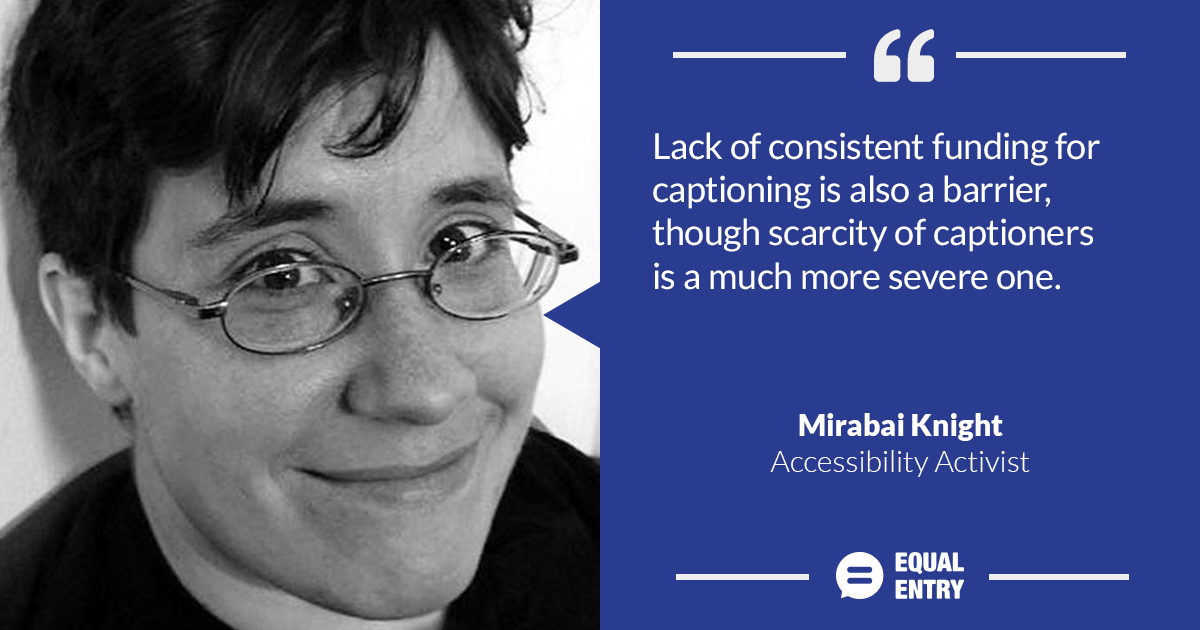Summary

This installment of our Accessibility Activists column is an interview with Mirabai Knight, a realtime captioner. Knight is also a contributor to the StenoSpeak for Android project.
When did you first get started in accessibility?
You could argue that my first entry into accessibility was in third grade when we were given the assignment to invent something and then draw up a mock patent for it, and I rigged up an old wooden pipe holder, a disc-shaped drill bit case, and a few other odds and ends into what I called the “Quadriplegic Pill Dispenser” (more accurately, a pill dispenser for quadriplegic people), which could be loaded up with a week’s worth of pills by an aid and then operated independently by a quadriplegic patient, who could use their nose to dispense a day’s worth of pills at a time.
My mom is a nurse, and she had introduced me to a paraplegic patient who had become a friend of hers, which I guess put the idea into my head of inventing a device for people with quadriplegia.
Fast forward a bit to my first job out of college, working the night shift at a group home for adults with developmental and physical disabilities in Missoula, Montana. I got hands-on experience with a lot of accessibility devices there, though most of them were non-electronic.
That job turned into a job as an overnight care attendant for a lawyer with ALS when I moved to New York City. She only had the use of her eyes at that point, so when she got an eye-gaze computer that allowed her to write emails and communicate with people using synthesized speech, it was a big step up from the transparent alphabet board and guesswork that we’d used for communication up to that point.
That summer I started steno school (after reading the “stenography” article on Wikipedia and realizing that getting paid to caption college classes for deaf and hard of hearing students was a much better idea, financially and otherwise, than going to graduate school myself), and shortly afterward I got a job at an offline television closed captioning company.
When I graduated from steno school two years later, I interned with a CART captioner, then struck off on my own, and I’ve been doing it ever since. It’s the best job I could ever imagine.
What is your current area of focus in the accessibility field?
I primarily caption college classes for deaf and hard of hearing students, specializing in medical and graduate-level work, but I also do a fair amount of conference captioning.
What accessibility barriers exist within your specific field?
There are far too few captioners to meet the need! One in seven people (over 35 million people in the US) have some form of hearing loss, and there are fewer than 500 certified realtime captioners in the entire country!
Lack of consistent funding for captioning is also a barrier, though scarcity of captioners is a much more severe one. That’s why I started The Open Steno Project, to get more people into steno so that we can greatly improve the pool of captioners working in the field.
What is one new technology that you are excited about for accessibility?
Cloth-embedded circuits, and wearable computing in general! I want a pair of steno pants!
I have had the pleasure of both reading Mirabai’s work as an audience member and having my voice presented as text through her capable hands. As a audience member with full auditory ability, I still found myself reading the presenter’s words in addition to listening to them. The presentation was an a11y NYC Meetup where Mirabai was providing CART service. Shortly after that presentation I attended another event with CART services–and when I had the vantage point of comparison–it was then I truly appreciated the level of mastery Mirabai brings to the field. If you ever have the option of choosing a CART service professional, I have yet to see a better option than Mirabai.